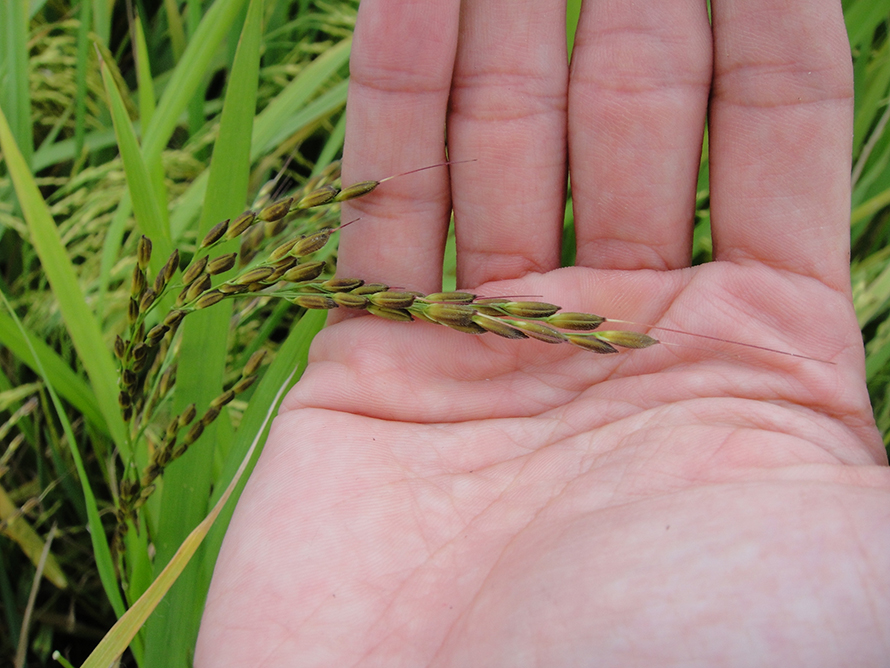Tags
Weedy rice gets competitive boost from its wild neighbors
Weedy rice is an agricultural pest with a global economic impact. It is an aggressive weed that outcompetes cultivated rice and causes billions of dollars in yield losses worldwide. In the U.S. alone, crop losses attributed to weedy rice could feed an additional 12 million people annually.

Kenneth Olsen
A study from Washington University in St. Louis offers new insights into genetic changes that give weedy rice its edge over cultivated rice in tropical regions of the world. Writing in Nature Communications, researchers report that one of weedy rice’s secret weapons is its promiscuity: Weedy rice readily crossbreeds with naturally occurring wild rice that grows nearby.
Biologist Kenneth Olsen, a George William and Irene Koechig Freiberg Professor of Biology in Arts & Sciences, worked with partners in China, Malaysia and Thailand to conduct this research. The scientists analyzed whole-genome sequences from 217 wild, weedy and cultivated rice samples and found that wild rice hybridization with weeds has contributed substantially to the evolution of Southeast Asian weedy rice.
“In the case of rice, the barriers to gene flow between the crop and its wild relatives are quite low compared to other crop species,” Olsen said. “These porous borders in rice can facilitate the evolution and adaptation of weedy crop relatives.”

KENNETH OLSEN
Rice farmers tend their fields in Thailand.
Overall, the genetic diversity of rice planted in Southeast Asia is higher than in the United States. There is a huge market demand for rice in this part of the world, and climate and environmental factors also play a role in the choices that farmers make when planting rice.
“Farmers in mainland Southeast Asia — including Thailand, Myanmar and Vietnam — and most of the island regions of Indonesia, Philippines and parts of Malaysia grow a wide range of lowland and upland rice varieties,” said B.K. Song, a Malaysian weedy rice researcher who is another corresponding author of the new study. “These include modern elite varieties and traditional landraces.”
Southeast Asian rice farmers have moved toward using some of the same mechanized planting technologies that are used by industrial rice farmers in the U.S. today.
But once in the ground, rice seedlings planted in Southeast Asia rub elbows with wild rice plants that are still found alongside cultivated rice fields today. This is something that doesn’t happen in U.S. rice fields.
“The common wild rice progenitor, Oryza rufipogon, is not present in the temperate zones, including the United States, northeastern Asia and Europe,” Song said. “Crossing between cultivated and wild rice in U.S. fields is impossible.”

BK SONG
When weedy rice and wild rice hybridize, weedy rice can develop freely shattering seed, which gives the weed an advantage.
In their new study, Olsen and his colleagues determined that hybridization between wild rice and weedy rice in Southeast Asia has enabled some weeds to become better adapted as agricultural weeds, giving them a competitive advantage over cultivated rice plants. For example, some of the weeds are highly effective at dispersing their seeds in rice fields because they carry wild rice gene copies that result in freely shattering seeds from the grain stalk.
The genomic results also indicated that Southeast Asian weedy rice has developed its tricks through many different evolutionary pathways running in parallel, including some weeds that de-domesticated, or became feral, after getting a start as cultivated rice, in addition to those that changed as a result of crossing with wild rice.
“Our study highlights how adaptive introgression — in other words, gene flow — from wild species can contribute to agricultural weed evolution,” Olsen said. “We’ve known that this process occurs for some time. But this is the first study to provide a detailed genomic characterization of the phenomenon.
“It’s important to recognize that crop domestication is an incremental evolutionary process, and not a single-step event,” he said. “Likewise, I think we run the risk of oversimplifying the picture by categorizing every rice plant as wild or weed or crop. The true dynamics are much more complex.”
And so, a global battle against weedy rice continues, with as many fronts as there are fields.
Tonapha Pusadee, another study co-author, said: “In Thailand, there are many ways to manage the weedy rice invasion in cultivated rice fields. For example, some farmers cut the panicles or use a chemical to eliminate the weedy rice, which is taller than the cultivated rice. Some farmers choose to leave the fields fallow for a few years.
“However, the management of weedy rice in Thailand so far has not been successful since weedy rice is more adaptive than cultivated rice in many traits, except grain-cooking quality!”

CHANYA MANEECHOTE
Weedy rice is an aggressive weed that outcompetes cultivated rice. Here, weedy rice is the lighter-colored grass that rises taller than the crop in a field in Thailand.
https://www.asbmb.org/asbmb-today/science/051824/weedy-rice-gets-boost-from-wild-neighborsPublished Date: May 18, 2024






